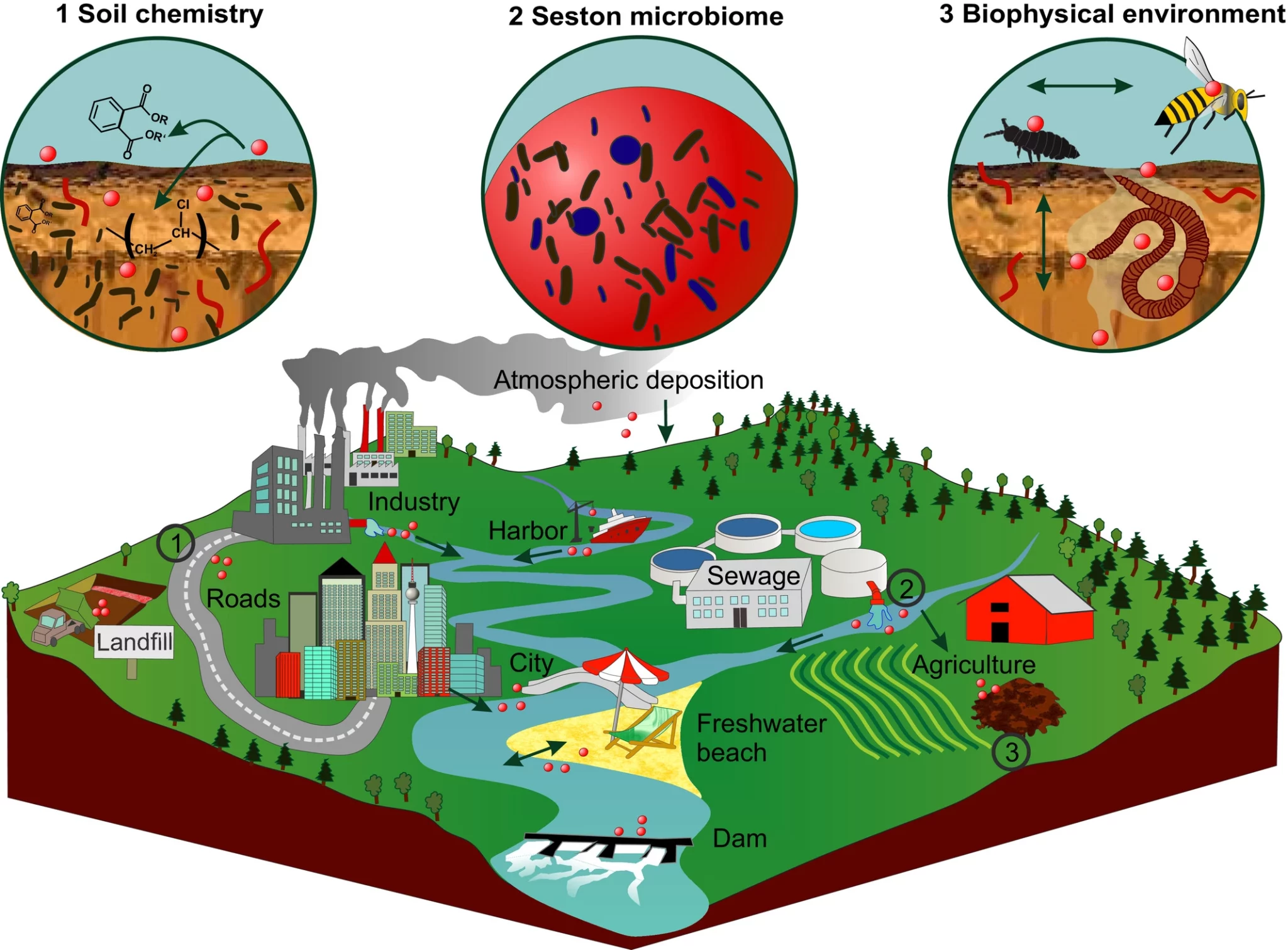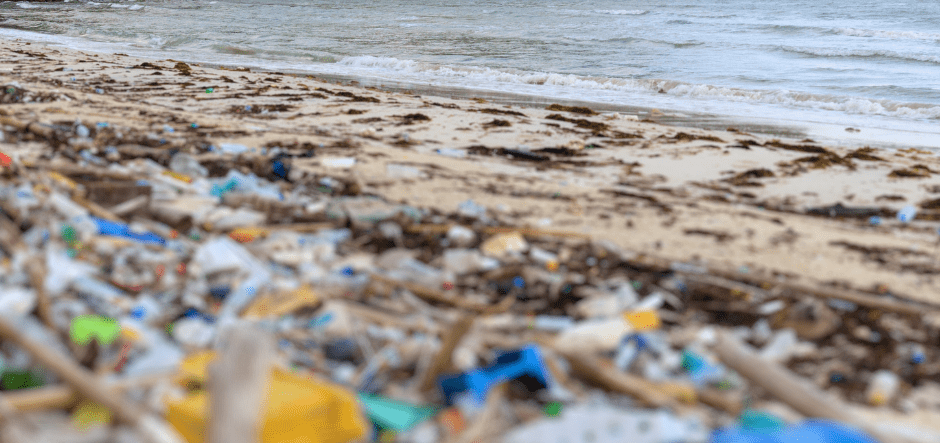Discover the latest studies about the impacts of microplastics pollution on ecosystems and coastal areas, and how Ascandra can help remediating to this issue.
The 20th century marked a turning point in the plastic industry, with an abundance of plastic-based products being manufactured, from buckets to cars. However, the 21st century has brought about the consequences of this overproduction. Poor management and disposal, lack of awareness of the negative effects, and irresponsible use have resulted in the earth becoming a “plastic planet.” Not only does plastic pollution harm the environment, but it also poses a threat to human and animal health. Plastic waste is often carelessly discarded into bodies of water, contributing to the problem of microplastics in marine ecosystems. These tiny plastic fragments are easily ingested by marine life, causing harm to their health and transferring pollutants through the food chain[1].
EMERGING CONCERNS ABOUT MICROPLASTIC POLLUTION
Various sources of microplastics have been identified in continental systems, including terrestrial, aquatic, and semiaquatic environments on land. Permissive levels of microplastics are allowed in industrial effluents, leading to significant emissions from production plants. For instance, a single plant in the Danube River could emit a substantial amount of industrial microplastics into the environment. Moreover, microplastic concentrations in rivers located in industrialized areas can be orders of magnitude higher than those found in marine environments.
One significant source of microplastics in continental systems is sewage treatment plants. Untreated domestic sewage contains fibers from clothing and microplastic beads from personal care products, which are rich sources of microplastic pollution. Although sewage treatment plants retain a portion of incoming microplastics in the sludge, significant amounts may still find their way into the environment, especially when the resulting biosolids are used as fertilizers in agricultural fields. Studies estimate that European farmlands receive an annual addition of 63,000 to 43,000 tons of microplastics through sludge application.[7]
Landfills, urban areas, and industrial centers also contribute to microplastic pollution on land. Accidental loss of particles, improper waste handling, and the generation of contaminated soils and aerosols all play a role in the direct input of microplastics into terrestrial environments. Moreover, atmospheric particles can transport microplastics over considerable distances, leading to contamination far away from the original source.Despite the pervasive presence of microplastics in terrestrial environments, there is a lack of standardized methods for measuring and reporting their concentrations. Existing techniques such as filtering, flotation, and visual selection have limitations when applied to continental systems. Filtering methods often underestimate the presence of particles smaller than the mesh opening, while visual detection is limited by human error and precision. Additionally, commonly used confirmation methods have size detection limits that exclude nanoplastic particles. The lack of standardized methods and particle size distribution data hampers accurate quantification of microplastics in continental environments.

TERRIBLE IMPACTS ON ECOSYSTEMS
Microplastics can have significant impacts on terrestrial ecosystems. In wastewater treatment plants, microplastics may carry pathogenic and opportunistic organisms, potentially acting as vectors for disease transmission in freshwater systems. In environments dominated by particulate material, microplastics can alter soil chemistry and affect soil organisms’ fitness and function. Earthworms and springtails, for example, have been found to transport microplastics within soil, leading to changes in soil structure and the gut microbiomes of these organisms. Microplastics may also interfere with plant-pollinator interactions, potentially affecting essential ecological functions.
One of the main impacts of microplastics on ecosystems is the harm they cause to wildlife. Many animals mistake microplastics for food, leading to ingestion and potential health problems such as starvation, suffocation, and entanglement.[2] Marine animals are particularly vulnerable, as microplastics have been found in the stomachs of fish, birds, and even whales. Another impact of microplastics on ecosystems is the disruption of food webs. Microplastics can absorb toxic pollutants, such as pesticides and industrial chemicals, which are then passed on to animals that ingest them. This can have cascading effects on entire food webs, as the toxins accumulate in higher trophic levels and can lead to the decline of entire populations of animals. [3] Microbial biofilms associated with microplastics can also negatively impact coral reefs by promoting pathogen transmission. Studies have also shown that corals consume microplastics at a rate of about 50 μg of plastic per square centimeter per hour, and that these ingested plastic fragments can be found in the mesenterial tissue within the coral’s gut cavity. The ingestion of microplastics by corals can lead to the retention of plastic fragments in mesenterial tissue, which reduces the ability of the coral to get nutriments and lowers its energy reserves.[4] Microplastics also have drastic effects on planktons, which are an essential component of marine life. Planktons, including phytoplanktons, heterotrophic planktons, and zooplanktons, are all affected by microplastics in different ways.
Phytoplanktons, which are responsible for producing a significant portion of the world’s oxygen and serving as the base of the marine food chain, can be negatively impacted by microplastics. Studies have shown that microplastics can reduce the ability of phytoplanktons to absorb chlorophyll, which is essential for their survival and growth. This can ultimately affect the entire marine food chain and the overall health of the ocean.[5]
Heterotrophic planktons, which consume other planktons and small organisms, can also be affected by microplastics. When they come into contact with microplastics, they can retain the tiny plastic fragments in their tissues. This can not only affect their ability to feed, but also their overall health and survival. Zooplanktons, which are basic primary consumers in the aquatic food chain, are also affected by microplastics. Due to their small size, zooplanktons can easily ingest microplastics, which can lead to a decrease in their feeding ability and ultimately, negative effects on their health. Studies have shown that microplastics can decrease the growth and reproduction of certain marine organisms, such as copepods, lugworms, and Hyalella azteca, which can have a ripple effect on the entire marine ecosystem.[6]
ASCANDRA, FOR MICROPLASTICS REMEDIATION
Microplastics pose a significant threat to continental systems, including terrestrial, and aquatic environments. The diverse sources of microplastics contribute to their widespread presence in these ecosystems.
Addressing the issue of microplastics requires urgent action and the development of innovative technologies. It is crucial to find effective solutions to mitigate the current presence of microplastics in ecosystems, oceans, and coasts. In this regard, Ascandra by Eden Tech offers hope in the fight against microplastics. This project utilizes cutting-edge microfluidics technology to filter microplastics from water at high throughput rates. By employing novel and innovative techniques, Ascandra aims to significantly reduce microplastic contamination, thus contributing to the preservation of ecosystem health and the protection of marine and terrestrial life.
In conclusion, while the challenges posed by microplastics in continental systems are significant, the development and implementation of innovative technologies hold promise for mitigating their impact. By promoting stricter regulations, comprehensive monitoring, and the adoption of novel solutions like Ascandra, we can strive towards a future where microplastics are effectively controlled, preserving the integrity and well-being of our ecosystems for generations to come.
Ascandra provides a viable solution to the growing problem of microplastic pollution in our oceans. By creating a protective shield zone through the cleaning of our coasts and rivers, this ultra-compact water filtration system effectively isolates and concentrates floating microplastics up to a million-fold, preventing them from entering our oceans. With the ability to collect microplastics down to a tenth of a millimeter at 1m3 per minute, Ascandra offers a high-tech and effective solution to this global issue. It is crucial that we start using innovative solutions such as Ascandra to remediate the microplastics problem, protecting not only our marine life but also ourselves and our planet.
References
[1] Authors: Browne, M. A., Crump, P., Niven, S. J., Teuten, E., Tonkin, A., Galloway, T., & Thompson, R., Marine Pollution Bulletin, 2011
[2] G.G.N. Thushari, J.D.M. Senevirathna, Plastic pollution in the marine environment, Heliyon, Volume 6, Issue 8, 2020,
[3] Verla, A.W., Enyoh, C.E., Verla, E.N. et al. Microplastic–toxic chemical interaction: a review study on quantified levels, mechanism and implication. SN Appl. Sci. 1, 2019
[4] Reichert, Jessica & Schellenberg, Johannes & Schubert, Patrick & Wilke, Thomas. Responses of reef building corals to microplastic exposure. Environmental Pollution. 237, 2017
[5] K. Nanthini devi, P. Raju, P. Santhanam, P. Perumal, Impacts of microplastics on marine organisms: Present perspectives and the way forward, The Egyptian Journal of Aquatic Research, Volume 48, Issue 3, 2022
[6] Fulfer Victoria M., Menden-Deuer Susanne, Heterotrophic Dinoflagellate Growth and Grazing Rates Reduced by Microplastic Ingestion , Frontiers in Marine Science 8 , 2021
[7] Nizzetto, L., Futter, M., & Langaas, S. Are agricultural soils dumps for microplastics of urban origin? Environmental Science & Technology, 50, 2016

Nour Chebbi
Head Of Marketing
M.Sc. Microfluidics

